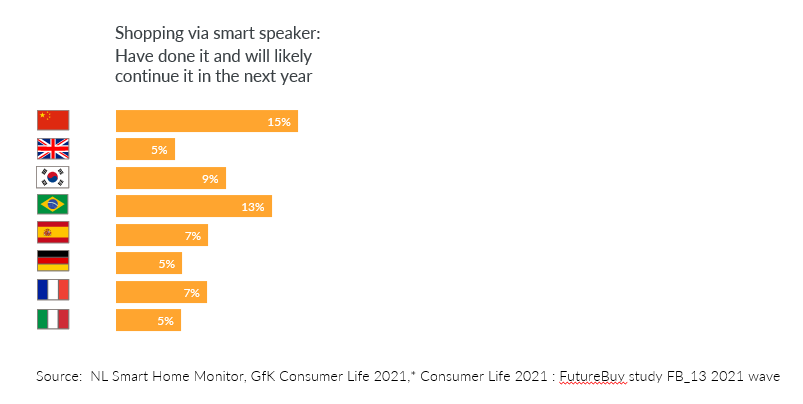E-commerce was already on the rise, but it became an essential part of the way societies engaged and made purchases during the COVID-19 pandemic. Not only did e-commerce provide an important way for businesses to survive a period of unprecedented disruption – it was a vital resource for those isolating, shielding, or just living in lockdown. This accelerated businesses’ adoption of e-retail, as well as the number of online sales – leading to the rise of digital consumers. The online sales share of technical consumer goods rose from 24% in 2019 to 35% in 2021.
In 2022, that figure has dropped slightly to 34%, with e-commerce plateauing after a period of strong pandemic-related growth. This normalization was expected as physical stores opened; however, it has plateaued at a level higher than it was pre-pandemic, indicating that some of the changes in consumer behavior are here to stay. Indeed, the acceleration of e-commerce adoption has introduced a range of new possibilities in digitization for brands and retailers. Consumers are open to engaging with brands and retailers across a range of sales channels, and brands that can create effective customer experiences (CX) will win new fans and boost sales.

E-commerce shows resilience despite uncertainty
Despite leveling off as pandemic-related restrictions and social distancing measures eased in many parts of the world, internet sales share continues to grow in China and Developed Asia. In other regions the share remains higher than the pre-pandemic levels but with deceleration over 2022. Globally, the share of internet sales relating to telecoms products has increased slightly while all other product category shares normalized this year. The share of internet sales looks set to grow as 50% of consumers plan to shop more online than they did before. However, this growth will come under pressure as a range of factors impact consumer confidence and spending power.

The ongoing conflict between Russia and Ukraine continues to exacerbate the supply chain issues impacting brands across a range of sectors. The increased cost of raw materials and ongoing shortage of key components such as computer chips mean the cost pressures affecting manufacturing are likely to increase over the short to medium term. For both businesses and consumers, high inflation and energy prices are impacting purchasing power. Consumer confidence is declining across the globe – with 43% of consumers reporting that they will wait longer before making a purchase. This makes it more important than ever that brands and retailers are making the most of every interaction with digital buyers.
Consumer confidence is in decline across the globe

An appetite for new experiences
With additional pressure on shrinking household budgets, brands and retailers will need to pull out all the stops to boost sales. Promotions remain an important e-retail tool to stimulate volume sales, but traditional approaches may need an update. So far, events like Prime Day and 618 shopping festival certainly triggered sales but their performance, while higher than the pre-pandemic levels, did not exceed last year’s performance. In fact, promotions and discounts have continued to decrease in 2022, and the unit share of products sold with a 10% price cut reduced from 23% in 2019 to 20% this year. Retailers need to consider carefully whether these lower discounts will serve to motivate digital buyers sufficiently.
Meanwhile, some brands are making use of innovative new sales channels to boost sales. In China, online sales increased by six percentage points, and this is mainly driven by the quick development of social commerce. For example, in the men’s shaver market, social commerce share within online sales contributes to 14% this year. This has helped digitally native brands to scale faster compared to other established brands.
Today’s digital consumer is leveraging technology to research and make purchases. 72% of people who own a voice-activated speaker use it as part of their daily routine, with 28% currently using it to make purchases. There is significant regional variance, however. 15% of voice-activated speaker owners in China have shopped via their smart speaker, while only 5% do so in the UK, Germany, and Italy. This shows that enabling adoption of smart speaker shopping is still a huge opportunity in some markets. This group will continue to gain traction as well as it starts to play a key role in the metaverse.
New channels. New opportunities
The success of social e-retail and voice-assisted shopping in China market shows the benefits that omni-channel integration can bring retailers. In an increasingly multi-channel marketplace, retailers need to be everywhere the customer is. Social media continues to gain traction across all segments – with 18% of social media advertisements in 2022 inspiring consumers to buy a new product, up 11 percentage points from 2019. Building awareness through sales channels like social can help cement loyalty.

For brands looking to expand their multi-channel presence, choosing the right segments, categories and technology are crucial. Smaller groups are currently able to outmaneuver larger ones due to targeting and investing in the right segments and product categories.
Conclusion
While e-commerce growth has plateaued after three years, activity levels remain higher than before the pandemic and consumer behavior has evolved. Digital buyers value being able to interact with brands and retailers in the way that suits them best in that moment – whether that is in store, online, or using both. Brands that can meet these changing expectations and provide seamless CX regardless of channel will be able to strengthen their position going forward. Building seamless journeys across channels relies on deep consumer understanding and insight.
![]()
![Understanding your audience: The power of segmentation in retail [podcast]](https://nielseniq.com/wp-content/uploads/sites/4/2025/07/Podcast-Understanding_your_audience-The_power_of_segmentation_in_retail-mirrored.jpg?w=1024)


